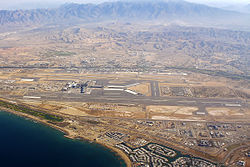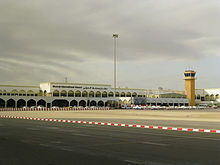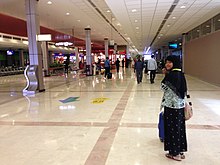Muscat International Airport
Muscat International Airport مطار مسقط الدولي | |||||||||||||||
|---|---|---|---|---|---|---|---|---|---|---|---|---|---|---|---|
 | |||||||||||||||
| Summary | |||||||||||||||
| Airport type | Military/Public | ||||||||||||||
| Operator | Oman Airports Management Company | ||||||||||||||
| Serves | Muscat | ||||||||||||||
| Location | Muscat, Oman | ||||||||||||||
| Hub for | |||||||||||||||
| Coordinates | 23°35′18.92″N 58°17′26.16″E / 23.5885889°N 58.2906000°E | ||||||||||||||
| Map | |||||||||||||||
| Runways | |||||||||||||||
| |||||||||||||||
| Statistics (2016) | |||||||||||||||
| |||||||||||||||
Muscat International Airport (IATA: MCT, ICAO: OOMS), formerly Seeb International Airport,[1] is the main international airport in Oman and is situated 32 km from the old city and capital Muscat within the Muscat metropolitan area. The airport serves as the hub for flag carrier Oman Air and features flights to several regional destinations as well as some intercontinental services to Asia, Africa and Europe.
History
The airport opened as Seeb International Airport in 1973, replacing a smaller airfield located in Bayt al Falaj.[2]
It has hosted Royal Air Force BAe Nimrods in the past, including for the 1991 Gulf War. These aircraft cooperated with the Royal Navy of Oman in the 'Magic Roundabout' exercise series.[3] The base was used by a detachment of Vickers VC10 tankers from No. 101 Squadron RAF during the Gulf War training with Royal Air Force SEPECAT Jaguars.[4]
As of 1 February 2008, the airport's name has been changed from Seeb International Airport to Muscat International Airport.[1]
Facilities
The entire airport is spread over an area of 5,250 acres (21 sq km). It originally featured one passenger terminal building, one runway as well as minor cargo and maintenance facilities and is currently undergoing a major extension and replacement consisting of a second runway, an entirely new passenger terminal and a new control tower. The new facilities are undergoing completion and testing as of March 2017.[5]
The facilities also includes a VIP terminal, and housing for airport staff as well as Oman Air employees. The Omani Royal Flight and Royal Air Force of Oman are based at the airport and the RAFO also shares its facilities with MCT.
Current Terminal
The airport currently features one single, two-storey passenger terminal. It has a T-shape and is equipped with 58 check-in counters, 23 departure gates, 4 baggage reclaim belts and some service counters and shops.[6] The building, dating from the 1970s, has been expanded several times during the last years to cater for growing passenger numbers.[6] However, it still has no aircraft stands equipped with jet-bridges, therefore bus-boarding is used for all operations. The existing terminal will be renamed to "Terminal 2" once the new terminal becomes fully operational and will handle low-cost flights.[citation needed]
Future Terminal
The current terminal will be replaced with an entirely new and significantly larger state-of-the-art facility to the north of the existing terminal and first runway. This new building, which is under construction as of June 11 2017, will initially bring the airport's capacity up to 12 million passengers a year upon completion of the first phase.[7] Subsequent enlargements under second and third phases will increase the airport capacity to 24 and 48 million annual passengers respectively.[7] The first stage will cover 580,000 sqm and will feature 118 check-in counters, 10 baggage reclaim belts, 82 immigration counters, 40 gates as well as a new ATC tower, 97 m high. The new terminal is located between the old and new runways and will be able to handle large aircraft such as Airbus A380s and Boeing 747s.[8] As of March 2017, the new terminal is planned to start operations at the end of 2017.[5]After the terminal is complete, it will be dubbed as "Terminal 1".
Runways and apron
The airport used to have a single runway. As of September 2016, a second newly built runway is already in use to the north of the new terminal building which can handle big airplanes such as the Boeing 747-8 and the Airbus A380 while the older one between the new facilities and the current passenger terminal is closed for refurbishment[9] as part of the construction of the entirely new main terminal building and apron area. The current apron features 32 stands[6] on both sides of the T-shaped passenger terminal building with 30 new ones being constructed in two phases[8] in front of the new terminal building of which several are already in use as of September 2016.
Airlines and destinations
Passenger
The following airlines operate regular scheduled and charter flights to and from Muscat:[10]




Cargo
| Airlines | Destinations |
|---|---|
| Cargolux | Chennai, Hong Kong, Luxembourg, Mumbai |
| DHL Aviation | Dubai-International |
Statistics
| Year[13] | Total passengers | Total Freight including Mail in Tons | Total Civil Aircraft movements |
|---|---|---|---|
| 2016 | 12,031,496[14] | N/A | 103,326[15] |
| 2015 | 10,314,449[15] | N/A | 94,920[15] |
| 2014 | 8,709,505[16] | N/A | 82,085[16] |
| 2013 | 8,310,927 | 120,040 | 81,244 |
| 2012 | 7,546,715 | 113,269 | 73,842 |
| 2011 | 6,479,860 | 98,780 | 68,696 |
| 2010 | 5,751,516 | 96,390 | 67,160 |
| 2009 | 4,556,502 | 64,419 | 55,330 |
| 2008 | 4,002,121 | 58,486 | 45,600 |
| 2007 | 4,220,429 | 77,292 | 45,655 |
| 2006 | 4,777,747 | 99,529 | 46,319 |
Accidents and incidents
- On 11 February 2013, a Pakistan International Airlines flight with 108 passengers had a providential escape when their flight from Sialkot nearly crash-landed at Muscat International Airport at 2pm due to ‘technical fault in landing gear’. All 108 passengers and crew were safe. The aircraft, a Boeing 737, has landed tilting on the left and the landing gear (rear Tyre) on the left of aircraft appears to have broken.[17]
Access
The airport is located near the Sultan Qaboos Highway between Muscat and Seeb. Taxis, car hire and chauffeur services are available. Public buses stop in front of the airport area on the highway.[18]
References
- ^ a b "Oman Airports". www.omanairports.co.om.
- ^ "Airport History". Oman Airports Management Company. Retrieved 24 October 2012.
- ^ Gp Capt Brian Burridge, Royal Air Force Nimrods in the Gulf
- ^ "19 Years Over Iraq". The Official RAF Annual Review 2010. Stamford: Key Publishing: 9. December 2010.
{{cite journal}}:|access-date=requires|url=(help) - ^ a b timesofoman.com - Muscat airport’s new terminal to be operational by end 2017: Al Futaisi 12 February 2017
- ^ a b c omanairports.co.om - Airport Development retrieved 30 September 2016
- ^ a b "New terminal complex for Muscat International Airport". Bechtel.
- ^ a b omanairports.co.om - New Airport Development retrieved 30 September 2016
- ^ "Pilot information for Muscat international Airport". Our Airports. Retrieved 5 February 2015.
- ^ omanairports.co.om - TimeTable retrieved 23 July 2016
- ^ http://www.routesonline.com/news/38/airlineroute/275682/salamair-adds-muscat-doha-from-nov-2017/
- ^ 2017, UBM (UK) Ltd. "Salam Air network expansion in May 2017". Routesonline. Retrieved 2 May 2017.
{{cite web}}:|last1=has numeric name (help) - ^ https://www.omanairports.co.om/Page.aspx?PGID=34&Tab=business
- ^ [1]
- ^ a b c [2]
- ^ a b [3]
- ^ gulfnews.com - PIA plane avoids crash at Muscat airport 11 February 2013
- ^ omanairports.co.om - Transportation from/to Muscat International Airport - Muscat Airport retrieved 23 July 2016
External links
![]() Media related to Muscat International Airport at Wikimedia Commons
Media related to Muscat International Airport at Wikimedia Commons

